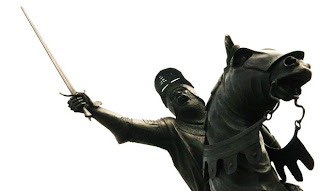by Judith Arnopp
Edward I’s defeat of Llewellyn
the Last in 1282 and his subsequent subjugation of the Welsh people caused
seething discontent among the Welsh. After a hundred years of continuing discontent, things finally reached boiling point when the English crown
refused to settle a land dispute between Baron Grey de Ruthyn and the forty-something, grey-haired and law abiding Owain Glyn Dŵr. It is difficult to access the
details of this matter but we do know that events quickly spiraled out of control and ultimately, Glyn Dŵr
took up arms against King Henry IV.
Glyn Dŵr himself, on calling
for Welsh assistance, is likely to have been surprised at the
alacrity of response. In September 1400 when he raised his
banner at Ruthin, supporters came from far and wide and, due to his descent from the Welsh Princes, they dubbed him, Prince of Wales.
In response, the English king marched
his army through North Wales burning and looting without mercy. The population
were easily quelled and sought peace with Henry, leaving Glyn Dŵr and a few
remaining supporters to take to the hills.
But things weren't over yet and the rebellion took off again
when Conway Castle was taken by the Welsh, allowing Glyn Dŵr access to mid and
south Wales. Consequently, the rebellion picked up momentum and Welshmen living
and working in England laid down their tools and returned home to join his
ranks.
It was around this time that
Henry IV, following Glyn Dŵr into the wilds of Wales, called at the home of Llewellyn
ap Gruffydd Fychan who lived in Caeo in Carmarthenshire.
According to the chronicle of Adam
of Usk, Llewellyn was a ‘bountiful’ member of the Carmarthenshire gentry, a
country squire whose household used ‘fifteen pipes of wine’ annually. This is
not to imply that the man was a drunk but shows him to be a wealthy and generous host.
At the time in question Llewellyn
was around sixty years of age, too old to fight perhaps, but it is believed two
of his sons were at Glyn Dŵr’s side. Henry
IV forced Llewellyn to lead him to Glyn Dŵr’s base camp, and for several weeks the
old man led the King on a goose chase through the wild uplands of Deheubarth, allowing Glyn Dŵr time to escape into Gwynedd and gain a position of greater
strength.
King Henry, cold, tired and
frustrated, realising somewhat belatedly what was afoot, forced Llewellyn to
admit his stratagem. Knowing full well what punishment lay in store, the
Welshman spoke out bravely as a loyal follower of Glyn Dŵr and supporter of
Wales.
On October 9th
1401 Llewellyn was dragged to the gallows at Llandovery Castle where he
was publicly disembowelled and dismembered in front of his eldest son. (Documentation does not make clear whether
this refers to Llewellyn’s eldest son or Henry’s.) As a deterrent to future rebels Llewellyn’s remains were displayed in towns across
Wales and his lands were granted
to Henry’s supporter Gruffydd ap Rhys. But the rebels weren't done with Henry yet and unrest continued for more than a decade.
It seems that Llewellyn ap
Gruffydd was not alone in his loyalty to the last Welsh Prince of Wales for, although Henry IV led one of
the largest, most feared armies in Europe (remember Agincourt a few years later
in 1415), Owain Glyn Dŵr, who had re-united the Welsh nation, was never captured,
mostly because his countrymen refused to betray him. His final end remains a mystery today.
Six hundred years later, in
1998, a campaign was started by residents of Llandovery to construct some sort
of a monument to their local hero, Llewelyn, and after an exhibition of proposed
designs in the year 2000, a statue by Toby and Gideon Peterson
of St Clears was chosen.
The effigy stands sixteen
feet tall and is fashioned of stainless steel, standing on a base of stone
brought from near Llewellyn’s home in Caeo. The figure of Llewellyn, clothed in
cloak, armour and wearing an empty helmet, stands proudly on the skyline, looking
out across the town of Llandovery as a mark of Welsh solidarity.
~~~~~~~~~~~~
Judith Arnopp writes historical novels set in the medieval and Tudor period. for more information please visit her website: www.juditharnopp.com
Photos from wikimediacommons.






Fascinating Judith and what evocative names...
ReplyDeleteWhat about Henry Percy 'Hotspur' the son of the Earl of Northumberland, he allied with Glyn Dwr too I believe, as did Edmund Mortimer, brother to the former Earl of March?
ReplyDeleteYes, Glyn Dwr had plenty of followers but I wanted this post to concentrate on Llewellyn ap Gryffydd Fychan because he is relatively unknown, even in Wales :)
ReplyDeleteNice post. Link shared :)
ReplyDeleteWhat a brilliant post!
ReplyDeleteI thoroughly enjoyed it, thank you very much for this. It's so hard to find clear, concise essays on Welsh history as they always assume the reader holds a degree in the subject. This was, for me, just right :-)
Thank you R. R.Jones - glad to be of service :)
ReplyDelete